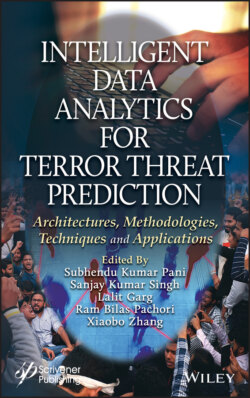Читать книгу Intelligent Data Analytics for Terror Threat Prediction - Группа авторов - Страница 48
1.6.1.1.1 Complete Observation
ОглавлениеFirst, Rumor source identification in networks was proposed in Ref. [9], to find source in network, consider a tree-like network as structure of network is one of the factors to detect source. The authors assume a node receives information from its neighbor nodes in trees. SIR model considered to find how this information is diffusion occurs from one node to other. Next factor to be considered is centrality measures, and gives knowledge about rumor centrality of one node, it is defined as a number of links from source node. If any node is having better rumor centrality it is considered as source of rumor diffusion. For more details see Ref. [45]. Rumor source estimator and maximum likelihood estimators are explained in following section.
1 A. Rumor Source EstimatorTo find rumor source estimator first need to know how rumor spreading over network? Rumor spreading model gives solution to this problem. There are many models like SI, SIS, SIR and SIRS uses as diffusion models to spread rumor over the network. These models are applied to diffuse information in online social networks. In this section a simple example is discussed on how a rumor can spread over the network.Let’s consider an undirected graph G (V, E), where V is a countable infinite set of nodes, and E is the set of form (i, j) for some i and j in V, and consider the case where initially only one node ν* is the rumor source. For the rumor spreading model, use popular model subject to infected or SI representation which does not permit for any nodes to get well, i.e. once a node with the rumor, it remains such forever. Once a node i with the rumor, it is able to widen it to another node j if and only if there is an edge among them, i.e. if (i, j) ∈ E. A node i needs the time to widen the rumor to node j is modeled by an exponential random variable τij has the rate λ. Suppose there is no loss of generality that λ = 0. All τij’s are autonomous and identically distributed [9].
2 B. Rumor Source Estimator: Maximum Likelihood (ML)Suppose that the rumor has widen in G (V, E) refer to diffusion model i.e. SI model and all N nodes with the rumor. Infected nodes are symbolized by rumor graph GN (V, E) which is a sub graph of G (V, E). It has been observed that actual rumor source (ν*) may differ than rumor estimator (). By using all these variables ν*, and GN, rumor source estimator is given as follows,(1.3) Where = rumor estimatorν* = rumor source.
In general trees, evaluation of P (GN|ν* = ν) is difficult. However in case of regular trees this evaluation is simple because every node has same degree. As the network is tree structure it is possible to spread rumor through unique sequence only. So that finding rumor source is also become simple. Evaluate P (GN | ν) for all ν ∈ GN and then select one with maximal value.
The authors consider general network, random tree, and d-regular tree to find rumor source. For d-regular and random trees it is easy to get information how rumors are diffusing in network as explained earlier but in general network it is difficult. So, they uses Breadth-First-Search (BFS) technique in general networks to convert them into BFS trees. Initially assume every node as a source node which means starting point for BFS. To find origin they used BFS tree with infection probability p. After finding, node which has higher probability considered as source node. For more details see Ref. [9].
